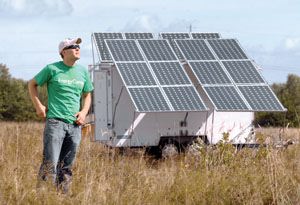A camp of energy purity
Ukrainian companies held a day of alternative energy opportunities
This weekend near Vyshhorod, on the bank of the Desna River, an “Energy Camp” emerged. Its uniqueness lay in the fact that all the energy needs of its residents (heating water, operating computers, TV-sets, etc.) were provided by the devices that produce energy from renewable sources, including sunlight. This is how the organizers of the Ukrainian Network of Energy Innovation “Greencubator” decided to demonstrate the viability of renewable energy. About a hundred people came to the bank of Desna to see it in action, including NGO leaders, businesspeople, bankers, journalists, inventors, students, and volunteers.
“The goal of this gathering is to demonstrate business opportunities to earn, save, make profits, and be socially responsible through renewable energy,” the coordinator of the Ukrainian Network of Energy Innovations “Greencubator” Roman Zinchenko told The Day. “The first ‘Energy Camp’ was held in 2009. The current gathering is the fourth. Si-milar power camps were held in the Crimea, Ivano-Frankivsk and Vinnytsia regions.”
“I wanted to have a first-hand experience of the functioning of devices that produce alternative energy. In addition, this activity is useful in terms of getting the latest information on domestic and world developments in this area,” said a student from the Department of Power Engineering and Automation of the Kyiv Polytechnics Natalia Halayko.
On the first day of the forum, near the tents where the participants stayed, the energy heart of the camp was installed: a mobile autonomous solar power station. “Its capacity is designed for 2.4 kW (in the future there will be devices with 3.9-10 kW power) per day,” said a participant of the gathering, the marketing and sales director of the Kvazar Company Oleksandr Lants. “In other words, it is able to provide for the energy needs for an average size home.” As Lants confesses, this equipment is one of the latest technical innovations of the company, designed specifically for the Ukrainian market. However, not everyone can buy this wonder of technology: it costs about 26 thousand euros (depending on capacity).
Devices heating the camp’s water were also supplied by the sun’s energy. During The Day, participants of the gathering were able to listen to experts on alternative energy talk about various technical innovations and socialize informally.
The second day was held under the theme “Youth Business Day,” during which there was a contest of young businesses using renewable energy devices. Five companies participated in the contest. They presented technologies on manufacturing micro converters (converting energy of the sun to the current of 220 W), producing combustible powders, producing extra-volume capacitors (accumulating power), LED-illumination (powerful illumination with small devices of 100 W), and so on. All of these technologies were developed in Ukraine. The winners of the project will be able to consult international gurus on preparing companies for market entry. “We suggest that young companies, which are just starting in this sector should show their wider capacity and improve their image, to show that they are ready for international competition and to get funding,” said Zinchenko.
Experts participating in the forum welcome such activities and see a radiant future for alternative energy in Ukraine. “The domestic market for renewable energy is huge and... empty, though with significant growth prospects,” says director of the Fuel Alternative Company Yulia Berezovska.
According to the KPMG public relations manager Alina Sevastiuk, alternative energy constitutes about one percent of the energy balance of Ukraine, while the average in the rest of the world is 14 percent. But the situation may soon change, predicts Berezovska. At least this is implied by the government. According to Berezovska, the National Agency of Energy Resources is now developing changes for the current “Energy Strategy of Ukraine till 2030,” proposing to increase the share of alternative energy sources to 30 percent.
The rapid development of alternative energy in Ukraine, according to Berezovska, will be facilitated by the decrease of financial incentives in this direction in leading European countries. For example, in Germany since July 1, 2010, the “green tariff” was decreased by 18 percent (the state provides a mandatory purchase of such electricity at a rate higher than traditional energy by the market), and its value will continue to decline. In Spain, this tariff was reduced back in 2008. “It immediately made the world’s renewable energy players seek new, riskier markets with an attractive growth potential, such as Ukraine,” continues Berezovska. Moreover, the expert adds, the Ukrainian “green tariff” is much more attractive and is expected to be in effect for 20 years. For example, for energy produced by solar power plants installed on land its value is six hryvnias including VAT, or more than 60 eurocents. “Global players consider markets where the ‘green rate’ exceeds 25 eurocents interesting,” explains the expert. Berezovska forecasts the major influx of foreign investments after the successful launch of the solar power plant with the capacity of 8 MW in Crimea, the construction of which has been recently mentioned by the President of Ukraine Viktor Yanukovych.
Representatives of the banking sector who studied projects and the market in general were present at the forum as well. According to loan development department manager of the ProCredit Bank Hanna Holiavko, by the end of 2010 the bank will introduce products financing energy-saving projects for small and medium businesses that provide 20-percent savings.
Alternative energy, according to Alina Sevastiuk, will develop successfully, but the state must provide additional incentives for investors, in line with global practice. In particular, the expert noted that in addition to the “green tariff,” it makes sense to make it state policy to search for alternative energy sources that can replace traditional solutions. For example, in Sweden the state’s goal is to abandon oil by 2020, replacing it by other sources.
n The Day’s FACT FILE
According to the KPMG’s survey, the support for renewable energy at state level began in 1978 in the US. Since 2002, a group of countries has begun to implement similar support. In 2008, Ukraine joined them. At present, 66 states, including all 27 EU member states, have strategic objectives to increase the share of renewable energy in the total energy balance of the country (from two percent to 78 percent).






